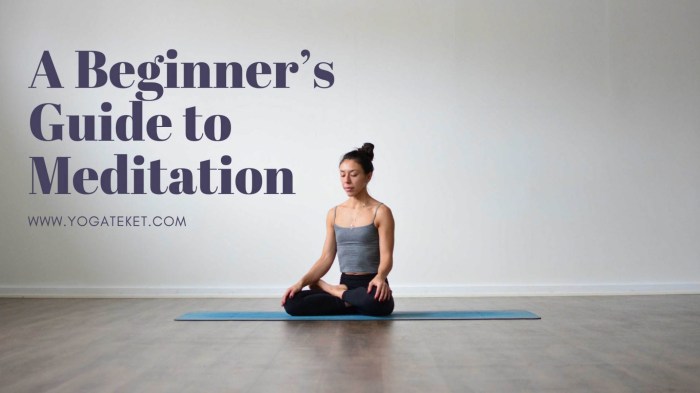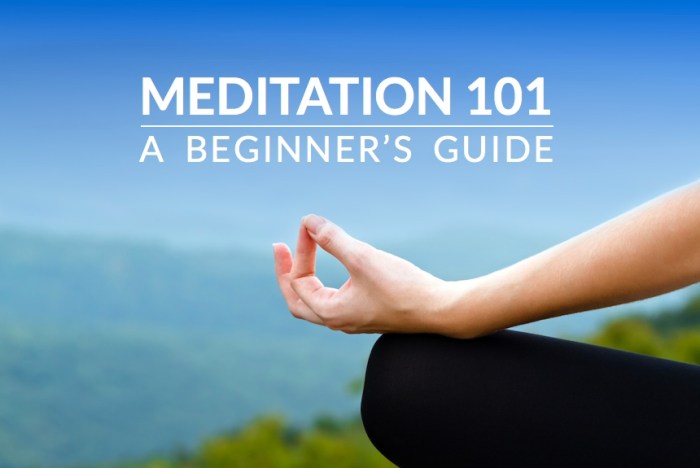Embark on your journey with 6 Simple Steps to Begin a Meditation Practice, unlocking the path to tranquility and self-discovery. Dive into the essence of mindfulness as we explore each step together.
Discover the key to starting a meditation practice that will transform your mental well-being and bring harmony to your everyday life.
Understanding Meditation

Meditation is a practice that involves focusing the mind on a particular object, thought, or activity to achieve mental clarity, emotional calmness, and a sense of inner peace. It is often used for relaxation, stress reduction, and improving overall well-being.
Benefits of Starting a Meditation Practice
- Reduced stress and anxiety levels
- Improved concentration and focus
- Enhanced self-awareness and mindfulness
- Promotes emotional health and well-being
- May reduce symptoms of depression
Different Types of Meditation Techniques
- Mindfulness Meditation: Focuses on being present in the moment and observing thoughts and sensations without judgment.
- Transcendental Meditation: Involves silently repeating a mantra to achieve a state of relaxed awareness.
- Loving-Kindness Meditation: Cultivates feelings of compassion and love towards oneself and others.
- Body Scan Meditation: Involves mentally scanning the body for sensations and focusing on each part with mindfulness.
- Guided Visualization: Involves creating a mental image or scenario to promote relaxation and positive emotions.
How Meditation Can Improve Mental Health
Meditation has been shown to have a positive impact on mental health by reducing symptoms of anxiety, depression, and stress. It can help individuals develop coping strategies, improve emotional regulation, and cultivate a more positive outlook on life. Regular meditation practice has also been linked to increased gray matter density in the brain, which is associated with improved cognitive function and emotional stability.
Setting Up Your Space

Creating the ideal environment for meditation is crucial to enhance your practice and overall experience. A calming and peaceful space can help you focus and relax your mind. Here are some tips on setting up your meditation space:
The Ideal Environment
- Choose a quiet and clutter-free area in your home where you can meditate without distractions.
- Natural light and fresh air can create a soothing atmosphere, so try to meditate near a window or in a well-ventilated room.
- Consider adding elements like plants, candles, or calming scents to enhance the ambiance of your meditation space.
Comfortable Seating
- Use a cushion or meditation pillow to sit comfortably on the floor, or opt for a comfortable chair if sitting on the floor is not suitable for you.
- Ensure that your seating arrangement supports good posture to prevent any discomfort or pain during meditation.
- Experiment with different seating options to find what works best for you and promotes relaxation.
Personalizing Your Space
- Add personal touches like inspiring quotes, images, or items that hold special meaning to you to create a more personalized meditation area.
- Consider incorporating elements that resonate with you spiritually or emotionally to make your meditation space a reflection of your inner self.
- Your meditation space should be a sanctuary where you feel calm, centered, and connected, so personalize it in a way that feels right for you.
Establishing a Routine

Establishing a routine is crucial for developing a consistent meditation practice. Consistency helps to deepen your meditation experience over time and allows you to reap the full benefits of this practice.
Importance of Consistency
- Consistency helps in forming a habit: By meditating at the same time every day, you train your mind and body to expect this practice, making it easier to stick to your routine.
- Enhances focus and relaxation: Regular meditation sessions can improve your focus, reduce stress, and promote a sense of calm and relaxation throughout the day.
- Progress and growth: Consistent practice allows you to track your progress, notice subtle changes in your mental state, and experience personal growth on your meditation journey.
Finding the Best Time to Meditate
- Choose a time that works for you: Select a time of day when you are least likely to be interrupted and can fully commit to your meditation practice.
- Morning vs. evening meditation: Some people find that meditating in the morning helps set a positive tone for the day, while others prefer evening sessions to unwind and de-stress.
- Experiment and adjust: Try out different times of the day to meditate and see what works best for you. It’s essential to be flexible and adapt your routine to fit your lifestyle.
Setting a Realistic Meditation Schedule
- Start small: Begin with short meditation sessions, such as 5-10 minutes, and gradually increase the duration as you become more comfortable with the practice.
- Be realistic: Set achievable goals for your meditation practice, considering your daily commitments and schedule. It’s better to meditate for a few minutes consistently than to aim for long sessions sporadically.
- Commit to regularity: Dedicate specific times each day for meditation, whether it’s in the morning, during a break, or before bedtime. Consistency is key in establishing a sustainable routine.
Integrating Meditation into Daily Life
- Combine meditation with daily activities: You can incorporate mindfulness practices into your routine activities, such as mindful breathing while walking or eating, to infuse mindfulness into your day.
- Create reminders: Set alarms or notifications to prompt you to meditate at your chosen times. This can help reinforce your routine and make meditation a natural part of your daily life.
- Stay committed: Stay dedicated to your meditation practice even on busy days. Remember that even a few minutes of meditation can have a positive impact on your overall well-being.
Practicing Mindfulness
Mindfulness is the practice of being fully present and engaged in the current moment, without judgment. It is a key component of meditation, as it involves focusing on your thoughts, feelings, and sensations without getting caught up in them. By practicing mindfulness during meditation, you can train your mind to stay present and aware.
Focusing on the Present Moment
- Begin by focusing on your breath, noticing the inhales and exhales as they happen.
- Pay attention to the sensations in your body, such as the feeling of your feet on the ground or the air on your skin.
- Acknowledge any thoughts or emotions that arise, but gently let them go and bring your attention back to the present moment.
Techniques for Staying Mindful throughout the Day
- Practice mindful breathing exercises during daily activities, such as taking deep breaths before a meeting or while washing dishes.
- Use reminders, such as setting alarms on your phone or placing sticky notes around your workspace, to bring your focus back to the present moment.
- Engage in activities mindfully, paying full attention to each task without multitasking or rushing through them.
Incorporating Mindfulness into Everyday Activities
- Practice mindful eating by savoring each bite, noticing the flavors, textures, and sensations in your mouth.
- Take mindful walks, focusing on the sights, sounds, and smells around you without distractions like headphones or phones.
- Practice gratitude by reflecting on the things you are thankful for each day, fostering a sense of appreciation and presence.
Breathing Techniques

Breathing plays a crucial role in meditation as it serves as a bridge between the mind and body, helping to anchor your awareness to the present moment. By focusing on the breath, you can calm the mind, increase concentration, and deepen your meditation practice.
Basic Breathing Exercises for Beginners
- Start by finding a comfortable seated position with your spine straight and shoulders relaxed.
- Close your eyes and take a few deep breaths, inhaling through your nose and exhaling through your mouth to release any tension.
- Shift your focus to your natural breathing pattern, noticing the rise and fall of your chest and abdomen with each breath.
- Practice diaphragmatic breathing by placing one hand on your chest and the other on your belly, focusing on deep belly breaths to promote relaxation.
- Experiment with different breathing techniques such as box breathing (inhaling for a count of four, holding for four, exhaling for four, and holding for four) to regulate your breath and calm the mind.
Breath Awareness in Meditation
Breath awareness is a fundamental aspect of meditation that involves observing the natural flow of your breath without trying to control it. By paying attention to the sensations of each inhale and exhale, you can cultivate mindfulness and develop a deeper connection with the present moment.
Tips for Deepening the Breath During Meditation
- Focus on taking slow, deep breaths to engage your diaphragm and expand your lung capacity.
- Incorporate breathwork techniques like alternate nostril breathing or ujjayi breath to enhance relaxation and concentration during meditation.
- Use visualization techniques to imagine your breath filling your entire body with each inhale and releasing tension with each exhale.
- Practice breath counting by silently counting each inhale and exhale, starting from one and working your way up to ten, to maintain focus and awareness.
- Avoid forcing your breath and instead allow it to flow naturally, embracing each moment of stillness and tranquility that arises.
Overcoming Challenges

Starting a meditation practice can be challenging, especially when faced with distractions, discomfort, or lack of motivation. However, by identifying common obstacles and implementing strategies to overcome them, you can establish a consistent and fulfilling meditation routine.
Dealing with Distractions, 6 Simple Steps to Begin a Meditation Practice
- Acknowledge distractions without judgment and gently guide your focus back to your breath or mantra.
- Experiment with different meditation techniques to find one that suits you best and helps minimize distractions.
- Create a dedicated meditation space free from potential interruptions to enhance your focus and concentration.
Handling Discomfort or Restlessness
- Practice self-compassion and remind yourself that discomfort is a normal part of the meditation process.
- Adjust your posture or position to alleviate physical discomfort and enhance relaxation during meditation.
- Focus on the present moment and observe sensations without attachment, allowing them to come and go naturally.
Staying Motivated and Committed
- Set realistic goals and start with short meditation sessions to avoid feeling overwhelmed or discouraged.
- Celebrate small victories and progress in your practice to maintain a positive outlook and motivation.
- Find a meditation buddy or join a community to share experiences, receive support, and stay accountable in your practice.
End of Discussion: 6 Simple Steps To Begin A Meditation Practice
In conclusion, embracing these 6 Simple Steps to Begin a Meditation Practice can lead to a profound shift in your perspective, allowing you to cultivate a sense of peace and balance within yourself. Start your meditation journey today and witness the transformative power it holds.